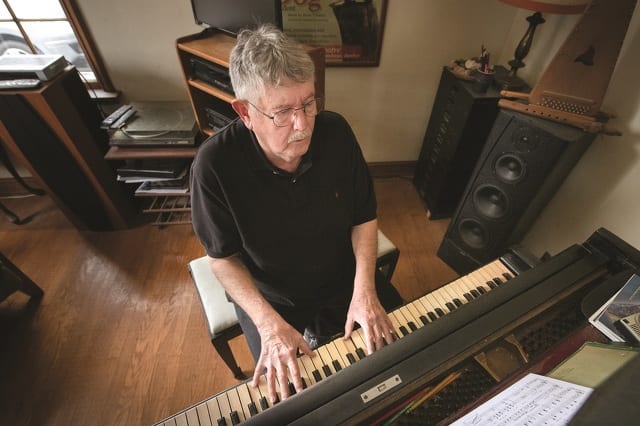
no description

no description
Each year, the Nittany Valley Symphony performs a family concert designed for young listeners and their parents. This year, the family concert’s theme is Dinosaurs on Parade, with works centered on everyone’s favorite ancient reptiles. On the program is a piece by Bruce Trinkley, professor emeritus of music at Penn State.
“We have a wonderful, wonderful symphony. Michael Jinbo is a beautiful music director and conductor. I’m thrilled as can be that they’re going to perform the piece,” Trinkley says of the concert, which takes place at 4 p.m. February 2 at Bellefonte Area High School.
While Trinkley has been hard at work adapting his piece, “Dinosaurs’ Dance,” based off a children’s book of the same name, for the Nittany Valley Symphony since last fall, the history of the work goes back much further.
Trinkley taught composition and orchestration and conducted the Penn State Glee Club from 1970 to 2006; he was music director for Penn State’s Centre Stage from 1970 to 1995. He originally wrote the piece in the 1980s.
At the time, he worked with Pat Heigel-Tanner, a professor of dance and movement at Penn State, to put together a piece for children to be performed by the Contemporary Dance Company. Originally, the work was written for solo soprano and piano, but later it was reworked for a children’s chorus, and now finally for the Nittany Valley Symphony.
This is not Trinkley’s first collaboration with the symphony, though.
“Over the years, I’ve conducted the Nittany Valley Symphony once or twice,” he explains. “I started up the women’s chorus at Penn State – it had been dormant for a number of years – and one of our first projects with the women’s chorus was doing a concert with the Nittany Valley Symphony. … Then, in 1996, for the State College Centenary, I wrote a big piece that involved a number of groups at the university and in town and the finale to that was for … the State College Choral Society and the Nittany Valley Symphony.”
For Trinkley, putting together a work such as “Dinosaurs’ Dance” is a multi-layered process. He often starts with a piece of text – a poem, prose, or play, and in this case a children’s book – and then forms the music around the text, considering the performer.
“If it’s a vocal piece, I obviously consider the voices. When I was adapting [‘Dinosaurs’ Dance’] for children’s voices, I considered the range and abilities of young singers,” says Trinkley. ‘Then likewise for the symphony … I know the capabilities of our wonderful Nittany Valley Symphony and I know a good number of the players, so I was thinking of them as I was arranging the piece.
“Then the third part of the puzzle is considering your audience. Since this is going to be the February Dinosaurs on Parade concert for young people, I was keeping that in mind, that I wanted to write something youngsters would enjoy. It’s a very tuneful piece. There are lots of melodies in it and things I think the children would enjoy hearing and I think their parents would enjoy also.”
Producing an enjoyable experience for the youngest attendees at the concert is a serious matter for both Trinkley and the Nittany Valley Symphony. Sometimes a symphony concert can be a little intimidating, both for children and adults, but giving individuals positive symphony experiences in childhood can produce lifelong classical music aficionados, he notes.
“If they have a good experience as a child at a symphony, they won’t be scared later in life,” he says. “They come to the concert because of the [family-friendly] programming and ideally I think then they enjoy it and when the symphony does a program that’s [more of its] mainstream repertoire … they will want to come back and hear [the symphony] again.”
Exposing children to live music is a valuable educational experience that’s difficult to replicate otherwise, he says.
“We see a lot of visual things on television, the movies and videos … but there’s really nothing like a live performance,” he adds. “I still remember going to my first symphony performance and my first opera. Hearing it live was so incredibly exciting. … I think for young people to go to a concert, to go out to Bellefonte to the high school and be in the auditorium and hear the music live … it’s the greatest musical experience of all.
“I think we’re so inundated with music through our devices that lots of times people forget that hearing music live is the ultimate musical experience. You can have the greatest headset in the world or the greatest Bose speakers, but there’s nothing like hearing a symphony orchestra live in a concert hall and seeing the players make the music as you hear it.”
Trinkley hopes families will take advantage of the opportunity.
“This is a wonderful chance for parents who care about their children’s artistic and cultural development to expose them to something different that they won’t experience at school or home or on their headsets,” he says. “This is the real thing.’
For more information on the concert, visit nvs.org.
Holly Riddle is a freelance writer in State College.
Receive all the latest news and events right to your inbox.

80% of consumers turn to directories with reviews to find a local business.